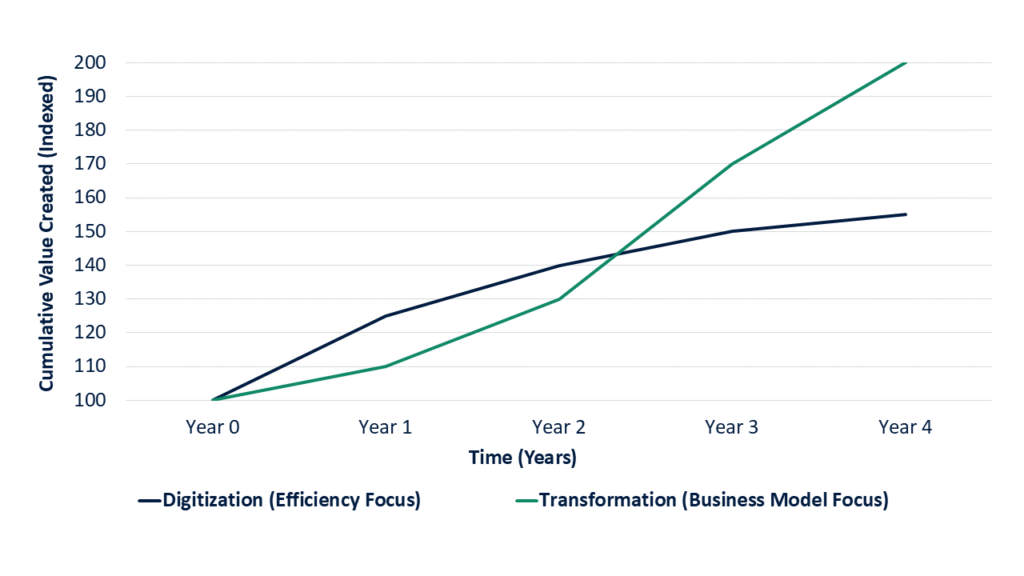For the past decade, “digital transformation” has been the reigning mantra of the corporate world. Companies have invested trillions of dollars in moving analog processes to digital channels: paper records became PDFs, in-person meetings became video calls, and manual spreadsheets migrated to the cloud. This digitization, the act of converting information into a digital format, has delivered genuine efficiencies. But it has also created a dangerous illusion of progress.
Many leaders now check the “digital transformation” box, yet wonder why they haven’t gained a significant competitive edge or seen explosive growth. The reason is simple: they stopped at digitization. True technology transformation is not about doing the same things with better tools; it is a profound business model revolution that leverages technology to create, deliver, and capture value in fundamentally new ways.
The Critical Distinction: Digitization vs. Transformation
Understanding this chasm is the first step toward genuine change.
-
-
- Digitization is using technology to support and optimize existing operations. It is inherently backward-looking, focusing on incremental improvement. Think of a bank offering a mobile app to check your balance, it’s a digital channel for a traditional service.
- Technology Transformation is using technology to redefine the core business itself. It is forward-looking and disruptive. Think of that same bank using AI and customer data to become a personalized financial wellness platform, offering automated investing, insurance, and lending products from itself and competitors – all within a single ecosystem.
-
The former makes the old model more efficient. The latter makes the old model obsolete.
Why Stopping at Digitization is a Strategic Risk
The comfort of digitization is a trap. It creates a facade of modernity while leaving the company vulnerable to disruption. Consider these compelling statistics:
-
-
- While 90%of executives have undertaken some form of digitization, only ~30% have successfully scaled digital initiatives beyond pilot programs to achieve operational impact.
- More alarmingly, 70% of digital transformations fall short of their objectives, often because they focus on technology implementation without changing the underlying business model or culture.
- Nearly 60% of CEOs are facing competitive pressure to adopt new business models, a clear indicator that incremental change is no longer sufficient.
-
These figures point to a stark reality: efficiency gains are quickly commoditized. A competitor can always build a slightly better app. But a competitor cannot easily replicate a deeply embedded, technology-powered ecosystem that delivers unique value to customers.
The Hallmarks of a Business Model Revolution
So, what does a true technology-driven business model revolution look like? It moves beyond efficiency to create entirely new sources of revenue and customer loyalty. Key characteristics include:
-
-
- From Products to Platforms: Instead of selling a product, you create a marketplace that connects different user groups. Adobe didn’t just digitize boxed software; it transformed into a creative and marketing cloud platform with recurring subscription revenue, a third-party plugin ecosystem, and community-driven value.
- From Transactions to Relationships: Technology enables a shift from one-off sales to continuous, data-rich customer relationships. Michelin transformed from selling tires to selling “tires-as-a-service,” using IoT sensors to monitor tire health on fleet vehicles and charging by the kilometer driven, aligning their success directly with customer efficiency.
- From Data Silos to Insight-Driven Value: Data becomes the most valuable strategic asset, used to hyper-personalize offerings and create new revenue streams. Netflix upended media not just by streaming video (digitization) but by using viewer data to inform content creation, marketing, and recommendations, fundamentally changing how entertainment is produced and consumed.
- From Ownership to Access: The model shifts to providing flexible access rather than permanent ownership. BMW and other automakers are building technology platforms to offer subscription services for features like heated seats and advanced driver assistance, creating continuous revenue streams from hardware already in the customer’s possession.
-
The Performance Chasm
The following chart illustrates the stark difference in outcomes between companies that pursue mere digitization and those that embrace full technology transformation. While digitization offers initial efficiency gains, these quickly plateau. Transformation, though requiring deeper investment and change, unlocks new markets, revenue models, and value, leading to exponential growth and a significant competitive moat.

Value Disparity: Digitization vs. Transformation
How to Lead a Business Model Revolution
Making this leap requires a fundamental shift in mindset and strategy from leadership.
-
-
- Start with the “Why,” Not the “What”: Begin by asking, “How can technology allow us to solve our customer’s problems in a way no one else can?” rather than “Which CRM system should we buy?”
- Embrace Ecosystem Thinking: Look beyond your organizational boundaries. How can you partner with or orchestrate other companies to create a seamless value proposition for your customer that you cannot provide alone?
- Reorganize Around Value Streams: Break down functional silos (IT, Marketing, Operations) and create cross-functional teams focused on end-to-end customer outcomes, empowered with the budget and technology to act.
- Cultivate a Culture of Experimentation: The new business model may not be clear at the outset. You must invest in rapid prototyping, test-and-learn cycles, and be prepared to fail fast and pivot. The goal is to discover the model, not just execute a pre-defined plan.
-
Conclusion: The Imperative to Reinvent
Digitization is the end of the beginning, not the beginning of the end. It is the necessary foundation upon which true transformation is built, but it is not the destination. In an age of AI, IoT, and hyper-connectivity, the greatest risk is not technological failure, but strategic timidity.
Leaders must look beyond automating the past and have the courage to invent the future. They must ask themselves the most critical question: Are we using technology to do what we’ve always done better, or are we using it to do something profoundly and disruptively new?
The companies that win the next decade will be those that see technology transformation not as an IT project, but as the catalyst for a complete business model revolution.
Ready to move beyond digitization? Our strategy consultants can help you envision and execute a technology-led business model transformation. Contact us to start your revolution.



